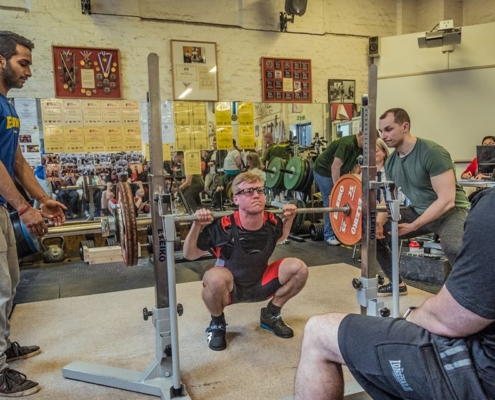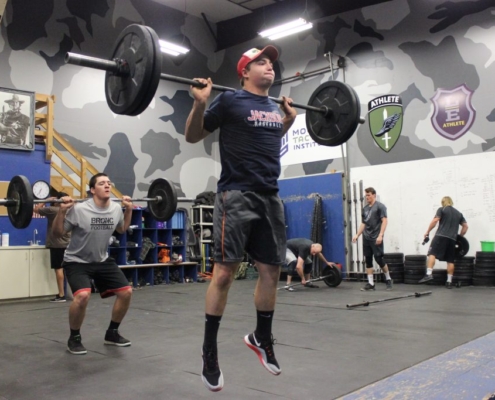Russian Special Strength Training (SST) – Part 1
This is the last blog post to round off my series on ”Power” development as it relates to jumping. There will definitely be a follow up on other concepts such as rotational power and upper body power, but I’ll save that for another day.
Special Strength Training Manual for Coaches – Vuri & Natalia Verkhoshansky (2011) has been a go to text for me over the years, and each time I read it I take another gem away. It’s certainly not an easy read, even with the good translation it’s still written in a pretty complex writing style so it can be hard to get through in parts.
In this Part 1 I’m going to summarise the main loading schemes used for resistance training. Part 2 will look at combined methods of Special strength training (SST).
Loading Schemes used in SST
The ultimate goal is to increase the level of maximal explosive force effort of similar movements using highly specific explosive strength exercises (jumps). Before the use of these highly specific explosive strength exercises, it is necessary to enforce the main muscle synergies (coordination), which ensure improvements in the CAPACITY TO OPPOSE THE FORCE OF GRAVITY: barbell squats, standing calf raises and more specifically, the seated calf raise.
These preliminary (General Preparatory) exercises are aimed at increasing maximum strength; they should be executed slowly with high overload ranging from 80 to 93% 1RM. In order to safely execute these exercises with high overload, it is necessary to carry them out starting from a lower load and gradually increasing it.
Maximum Effort Method
This allows an athlete to perform the exercise at a high level with one or another characteristic of movement i.e., speed or power. This method is used for development of Maximal, Explosive, Starting (Ballistic) and Reactive Strength. The rest periods between sets should be of sufficient duration to restore the body back to ‘optimal’ condition.
The main variant of the Maximum Effort Method is 2-3 repetitions with 90-95% of 1RM with obligatory muscle relaxation between repetitions. This involves racking the bar in between reps, known as a cluster set. Training sessions consist of 2-4 sets with 4-6 minutes rest periods.
Periodically, once every 2-3 weeks during the off-season and once every 1-2 weeks during the pre-season, a different method can be used.
Refusal Method
If the resistance exercise allows one to execute a specific number of repetitions in the form of a repetition maximum, until failure, it is recognised as the Refusal Method.
This uses a resistance that allows one to execute a specific number of repetitions in the form of a repetition maximum e.g., a 10 RM prevents an 11th rep. This method is used mainly for Strength Endurance. The work is performed, for example, in 4 to 6 sets with rest between varying from 30 seconds to 2 minutes. If the ‘work to failure’ method is executed with more sets, the amount of resistance must be reduced, in order that only 10 repetitions are executed each set.
This method is characterised by sub-maximal work intensity and volume, and a load slightly lower than the Maximal Effort Method.
Rest Periods
Depending on the length of the rest periods between each set, two different methods may be classified: Repeat Method and Interval Method.
If the rest period between sets of exercises is of sufficient duration for the restoration of the body back to an optimal condition it is recognised as the Repeat Method. The repeat method is used for the development of Maximal Explosive, Starting (Ballistic) and Reactive Strength.
If the rest period between sets is not of sufficient duration for the restoration of the body back to an optimal condition it is recognised as the Interval Method. The interval method is used for the development of Strength Endurance.
Repeat Method Examples
VARIANT 1 – Increasing Maximal Strength with muscle hypertrophy
- Resistance 75-80% 1 RM
- Execute slow movements until desired fatigue is reached
- Perform 2 sets with 2 minutes rest periods for 2 to 3 muscle groups
This method is not effective for improving speed, but it is useful at the beginning of the off-season training to prepare the muscles for heavier workload.
VARIANT 2 – Increasing Maximal Strength with minor muscle hypertrophy
- Complete 3 sets: 80% 1 RM, 90% 1 RM and 93% 1 RM
- 2-4 minute rest periods between sets
In each of the variants, the muscles must not be relaxed between the movements (repetitions). Unlike the Maximal Effort Method, all repetitions of a single set are performed continuously.
VARIANT 3 – Increasing High-Speed Strength
- The overload weight is limited to 30-70% 1 RM
- Perform 6 to 8 reps with maximum velocity in the miometric (overcoming) regime and moderate tempo in the pliometric (yielding) regime, relaxing muscles in the most advantageous mechanical position after each repetition.
I would also add here ”Vertical jumps with a barbell” (for starting strength aka ballistic strength) with loads of 30-60% 1 RM and 4-6 reps. They must not be executed as consecutive jumps, but as a ‘set’ of single jumps, where you stop and relax (shake) the legs, one after the other (the athlete can also rack the barbell). Verkhoshansky refers to this loading as Explosive strength, but at APA 30-60% would fall in the Ballistic strength category.
When the athlete already has a high level of Explosive Strength but needs to further increase it, they should use the Vertical Jump with a barbell with 4-6 reps with an overload of 50-60%, executed with relaxation of the legs between each jump.
VARIANT 4 – Increasing speed and frequency of unloaded movements
- Resistance 15-20% 1 RM
- Perform 8 to 10 reps with maximum movement tempo to emphasise frequency of movement. If emphasising speed then frequency has to be moderate and muscle relaxation movements are to be performed in between repetitions.
Interval Method Examples
This method uses repeated sub-maximal intensity exercises with shorter rest period than in the Repeat Method. This method increases the power and capacity of energy supplying mechanisms.
VARIANT 1 – Increasing Maximal Anaerobic Power and the capacity of Creatine phosphate (CP) mechanisms:
- Resistance is limited to 30-40% 1 RM
- The work must not lead to fatigue, evident when the speed and frequency of movement decrease
- Work for 10 seconds with maximal effort.
- Tempo is one movement per second.
- Rest periods are 30 seconds initially, but with an athlete’s improvement in performing the exercise, it should gradually be decreased to 10 seconds.
- At the beginning of the workout, only 5-6 reps should be performed. Over the course of continued training sessions the number of repetitions has to be gradually increased until 8-10 repetitions.
VARIANT 2 – Increasing Power and the capacity of glycolytic mechanisms:
- Resistance is limited to 30-40% 1 RM (same as variant 1)
- The work must not lead to fatigue, evident when the speed and frequency of movement decrease
- Work for 30 seconds with moderate effort.
- Tempo is one movement per second.
- Rest periods are 60 seconds.
- 6-8 reps should be performed.
In both variants, the training effect of exercises has to be increased by:
- Increasing external resistance while preserving the same tempo of repetitions;
- Increasing the temp of repetitions using a constant resistance.
*It is not entirely clear what the optimum loads are for the ”jump exercises with overload,” as a few different loading schemes are mentioned. Consecutive Barbell jumps consist of completing 10-20 of one of the following jumps:
- Barbell Squat jumps – also termed parallel squat jumps with the barbell on the shoulders, executed by bending the knees at least until the thighs are parallel to the floor, and then jumping upwards.
- Barbell Scissor-lunge jumps – jump out from a lunge (stride) position with a switch in the legs during flight, alternating them on every rep.
Now, it was recommended to perform 2-3 sets of 12-15 repetitions at a 20 RM in a Preparatory block used in Tennis, which equates to 60% 1RM. I personally wouldn’t want to do consecutive parallel barbell squat jumps at that load but that is just my personal opinion, so I think the 30-40% 1 RM is more realistic.
With 10-20 repetitions performed in an aerobic regime are used to improve local muscular endurance; they may also be used as a means of developing Explosive strength for athletes with:
- a low level of special strength preparedness
- a high level of special strength preparedness, at the beginning of a preparation period.
Hope you have found this article useful.
Remember:
- If you’re not subscribed yet, click here to get free email updates, so we can stay in touch.
- Share this post using the buttons on the top and bottom of the post. As one of this blog’s first readers, I’m not just hoping you’ll tell your friends about it. I’m counting on it.
- Leave a comment, telling me where you’re struggling and how I can help
Since you’re here…
…we have a small favor to ask. APA aim to bring you compelling content from the world of sports science and coaching. We are devoted to making athletes fitter, faster and stronger so they can excel in sport. Please take a moment to share the articles on social media, engage the authors with questions and comments below, and link to articles when appropriate if you have a blog or participate on forums of related topics. — APA TEAM






